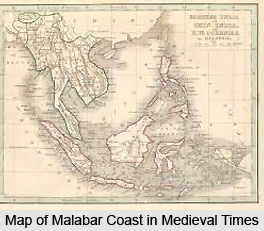 After the defeat of Rich Devagiri, the sultans made the Deccan as a base of operations for southern invasions.Malik Kafur the commander general of Ala-ud-in Khilji`s army invaded South India and conquered four Hindu kingdoms (1310 A.D.). That was the first time the Pandyan kingdom tasted Islamic invasion. In 1327 Muhammad bin Tughluq invaded Warangal and annexed it to the Tughluq Empire; he then turned his eye towards Dvarasamudram, which he completely destroyed. Then Srirangam was sacked and Ma`bar was taken.
After the defeat of Rich Devagiri, the sultans made the Deccan as a base of operations for southern invasions.Malik Kafur the commander general of Ala-ud-in Khilji`s army invaded South India and conquered four Hindu kingdoms (1310 A.D.). That was the first time the Pandyan kingdom tasted Islamic invasion. In 1327 Muhammad bin Tughluq invaded Warangal and annexed it to the Tughluq Empire; he then turned his eye towards Dvarasamudram, which he completely destroyed. Then Srirangam was sacked and Ma`bar was taken.
Ma`bar territory comprised of 23rd southern province of the Tughluq Empire. Ma`bar literally means `passage`. Jala-ud-din Ahsan Shan was then appointed governor of Ma`bar in 1329-30 A.D. Muhammad`s coins dated 1330, 1333, 1334 have been found at Madurai. This means that during this period Muhammad`s control over the Madurai region could have been quite effective. However in 1335 we find Jala-ud-din`s own coins becoming evident in that region. It follows that he had rebelled in 1335. Muhammad led a punitive expedition against this rebelling governor with the intention to punish him. But on reaching Warangal he was obliged to return to Devagiri (Daulatabad) because an epidemic broke out in his camp. The Sultan never reached Madurai and the Governor who escaped punishment, proclaimed an independent Sultanate in Madurai in 1335 A.D. This is known as the Sultanate of Ma`bar.
Jala-ud-din Ahsan Shah ruled till 1340 and he married a daughter of Ibn Batuta, the famous African who travelled in India. This Sultan, though he escaped Tughluq`s punishment, fell but was assassinated by one of his own officers Ala-ud-din Udanji in 1340. The assassin enjoyed the fruits of murder for a short while. Udanji led a couple of successful skirmishes against some Hindu force, but died in a few months. The story of his attack on the Hindu state of Dwarasamudra is narrated by different scholars. The legendary story of his being killed by an arrow shot by an unknown hand at the hour of victory against Vira-Ballala III is embroidered and woven into a regular military romance by imaginative historians but the details of the conflict are imperfect. The assassinated king was succeeded by his son-in-law Kut-bud-din Firoz who was murdered forty days after his succession. He was succeeded by Ghiyas-ud-din Damghani, who had served as an officer in the Tughluq army.
Ghiyas-ud-din had a number of atrocious cruelties to his credit. He was an absolute sadist and used to delight in torturing others. Massacre of prisoners, impalement of men on stakes, strangling of women and butchering of children were pleasurable to him.
Even during the days of Adil Shah, Bukka I the Vijayanagar ruler (known to Muslim historians as Bakan) raided Ma`bar i.e., in 1351 and considerably weakened die Sultanate. In 1371 Kumara (the junior) Kampanna invaded Ma`bar, defeated the Sultan and included the province in the Kingdom of Vijayanagar. Sikandar Shah dies last Sultan however ruled in a minor capacity till 1378 at least somewhere in Ma`bar, for his coins of that date are available.
The rule of die Sultans of Madurai was short - it did not last for more tlian thirty years but was quite bitter. The description of Muslim government in Ma-`bar by Gangadevi, one of the wives of Kumara Kampanna, in her Madbura Vijayam can well be an exaggeration considering that she could be treated as a biased.



















